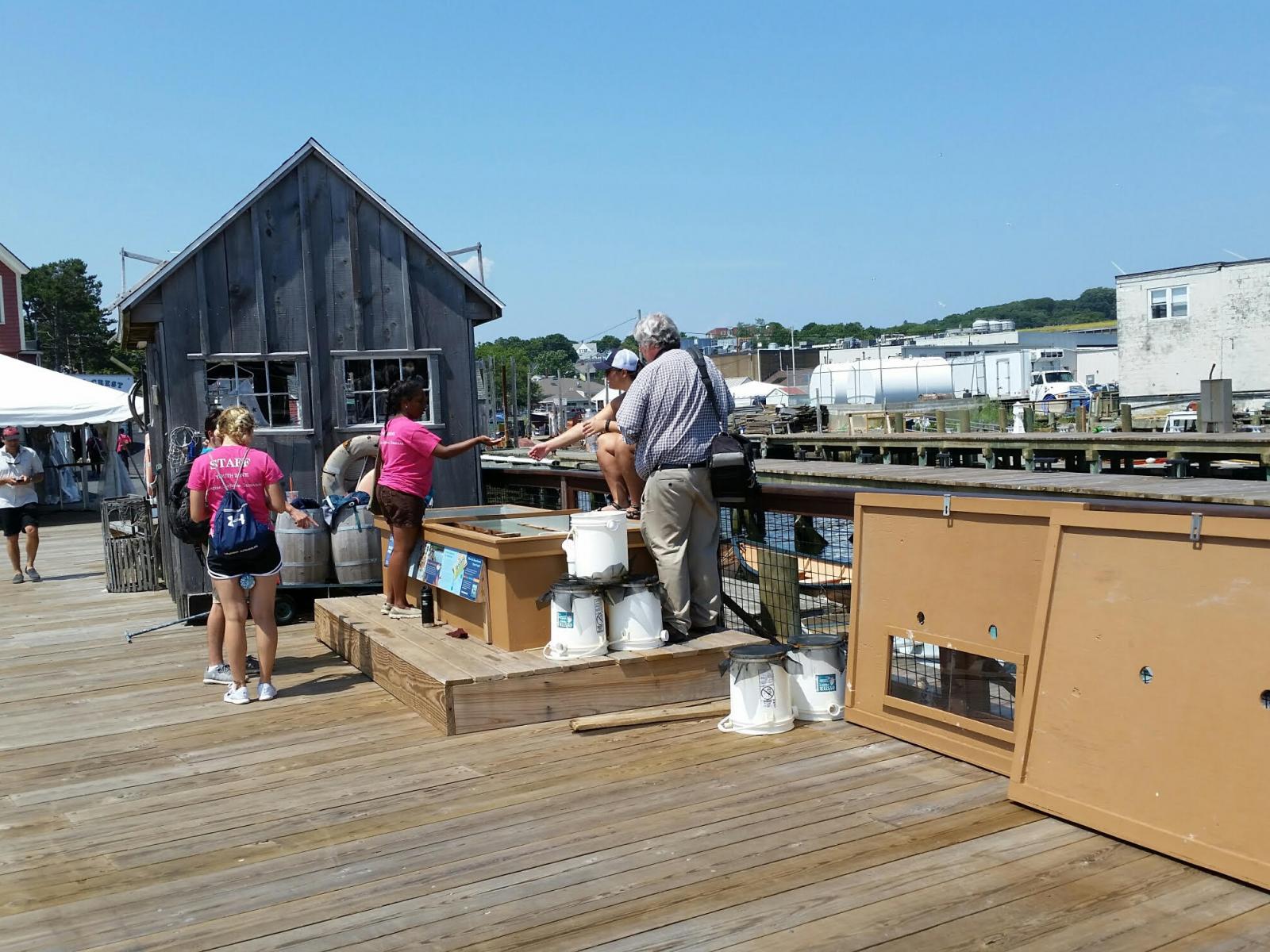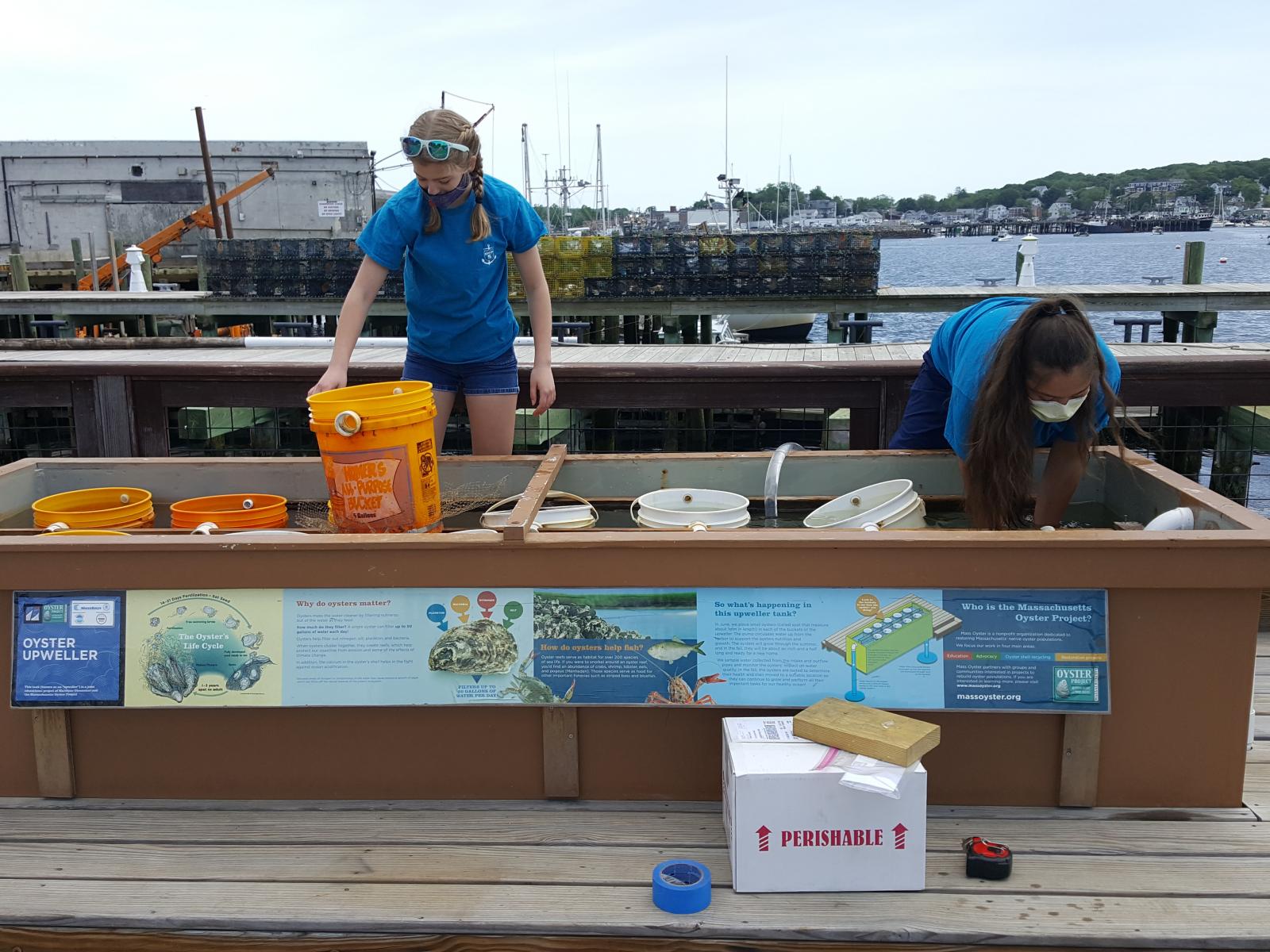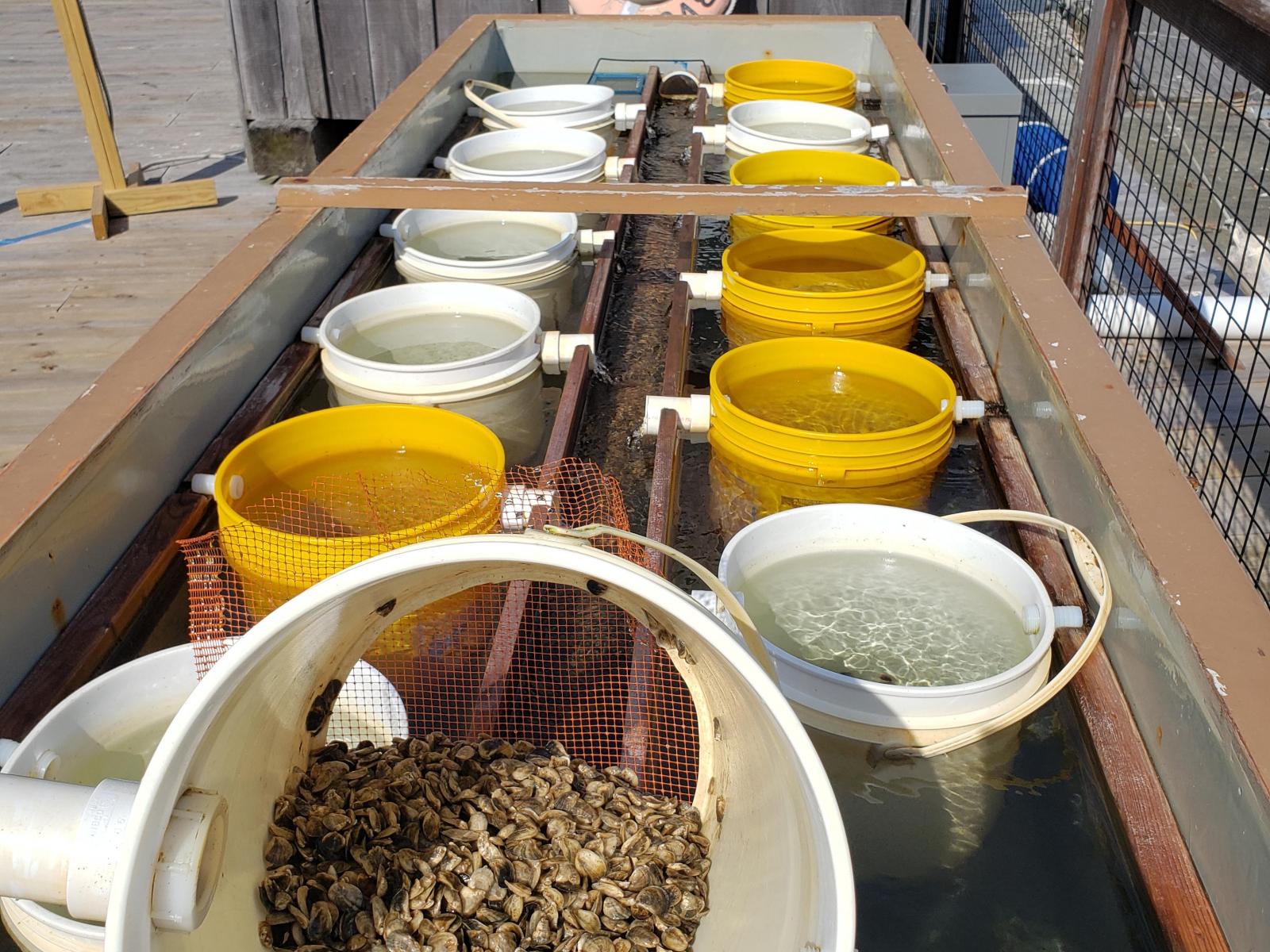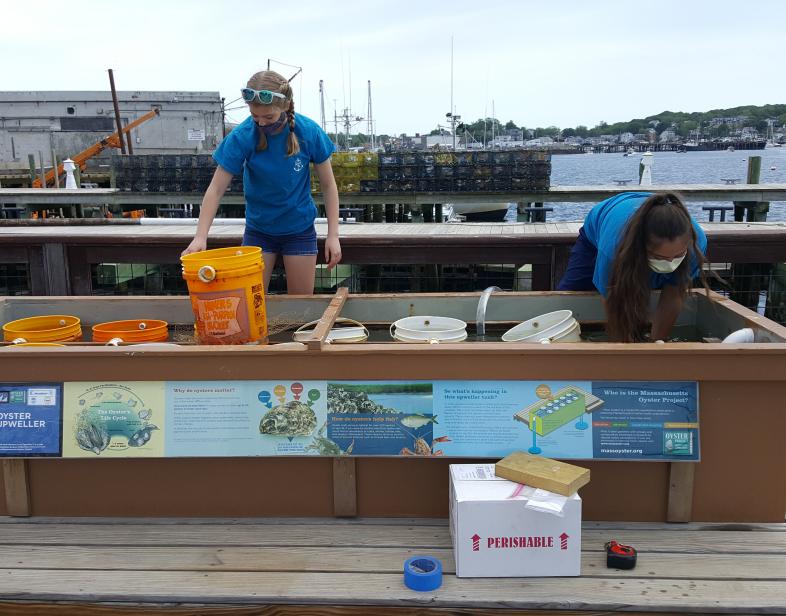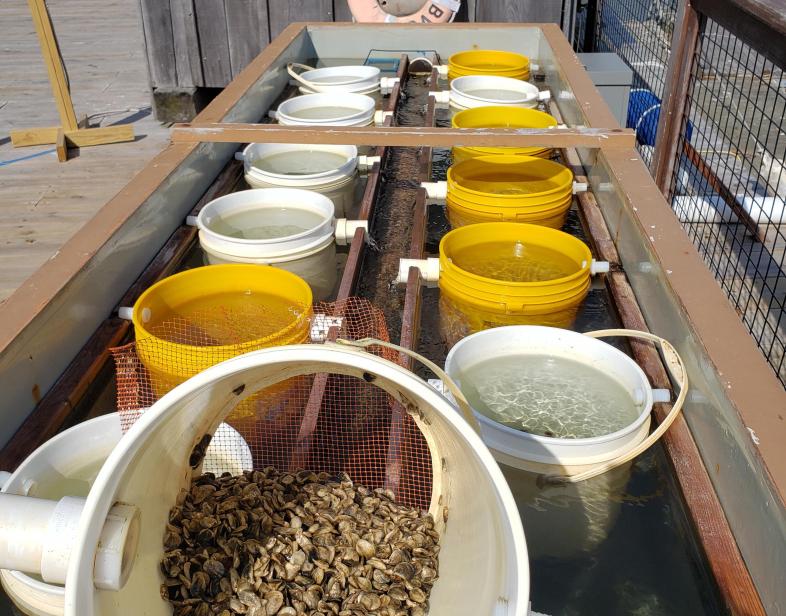An Overview Of Our Solution
Every summer, the Massachusetts Oyster Project operates upweller nurseries (above ground tanks with circulating water pumped from the harbor below) at high traffic locations to educate the public about the environmental benefits of oysters. At the end of the season, the oysters grown will either be released into the wild or donated to the local town for their recreational harvest. We have grown our program to 4 locations - Gloucester, Marblehead, Hyannis and Nantucket. The upwellers in Gloucester and Marblehead are maintained with the help of youth groups, which not only gives kids hands-on learning opportunities but also teaches them how to communicate with the general public. Our Hyannis upweller is near the busy ferry terminal and college interns educate visitors about oysters. Nantucket's upweller is at a busy marina. We release almost 240,000 annually.
- Population Impacted: 5000+
- Continent: North America
First name
Last name
Organization type
Context Analysis
Currently Massachusetts has some of the strictest regulations in terms of oyster restoration. Because of the National Shellfish Sanitation Program (a public health program/priority) and the state's multimillion dollar aquaculture industry, Massachusetts regulates oyster restoration very conservatively. Only in areas open to harvest are we allowed to release oysters, not in the critical closed areas (such as the entire Greater Boston area) due largely to water pollution, for fear of growing contaminated oysters. We have made some inroads to changing this. 3 of our upwellers operate in closed areas as the oysters are kept locked up. We have several efforts in place to try to change these rules. We have submitted input at the state level (MSI) and have a bill (HD4257) to make these changes legislatively. More importantly, we have been making the public aware of these limitations and asking for their support to make changes at the local and state level
Describe the technical solution you wanted the target audience to adopt
An adult oyster can filter up to 50 gallons of water in a single day. They remove nutrients, bacteria and sequester in their feces sediment and other particulates from out the water column. The oysters in our upwellers are filtering the nutrient- and bacteria-laden water that is circulated through their tanks for the season. Once they are released, the oysters will continue to filter the water in their new home. In the case of our North Shore (Gloucester and Marblehead) oysters, they are released in the wild where they will reproduce to build a larger oyster population with even more filtering capacity. We have been working with local towns to build sustainable oyster beds, most notably Gloucester, where we have built an entire science-based monitoring project around our oyster bed in the Mill River. We have been monitoring and adding to the population in the Mill River since 2017 and we are now trying to assess the impact of the harvest on that bed as well
Describe your behavioral intervention.
Since our upwellers are located in high-traffic areas, we take that opportunity to educate the general public about oysters, their environmental benefits and various other oyster-related issues in Massachusetts (and beyond). We have educational signage, times when volunteers/interns are on-site to engage with the public personally, an informative website, and in some locations regular youth groups that help hands-on with the maintenance of the upweller and communicating with the public. In Gloucester, the upweller regularly hosts school groups, where a curriculum has been developed to teach kids in a hands-on field trip environment. We hope to expand our educational curricula in the future to impact more schools and youth groups.
The people who have the opportunity to visit the upwellers come away with more appreciation for an oyster, as most have never thought of them as anything but food before. They can touch the baby oysters and look at their shells. They can ask questions and the conversation can lead down many pathways depending on what people's interest is, whether it's nitrogen removal, shell recycling, climate change mitigation or aquaculture.
Behavioral Levers Utilized
As needed, please explain how you utilized the lever(s) in more detail.
Oysters are something that most people have never given a single thought to, except perhaps as an appetizer at a restaurant. One of our main missions is to educate. At the upwellers, people get to touch and learn about oysters, often for the first time. This is an Information lever.
Often during our discussion at the upweller, folks will learn something about oysters that will fascinate or motivate them, such as the limitations to oyster restoration in Massachusetts or the fact that so many oyster shells go into a landfill instead of being recycled. These are examples of the Emotional Appeal lever. Similarly, some of what they learn about might cause them to make some changes to their habits, such as choosing to find a local solution to compost or recycle their oyster shells. This would be an example of the Choice Architecture lever.
We are also trying to make some changes to the strict regulations surrounding oyster restoration, utilizing the Rules & Regs lever.
Describe your implementation
When we proposed our first upweller project in Gloucester in 2016, there was initially a lot of opposition both at the local and state level. An educational aquaculture project aimed at educating the public about oysters and shellfish had not been done before. Concerns from the clamming industry (encroachment on grounds; not an issue as oysters and clams need different substrates), the volatile term "aquaculture" (Gloucester has a very strong tradition of ocean harvest and believes in the Commons), and state regulators (NSSF compliance; oysters are locked up and released elsewhere) were addressed and overcome. With perseverance we got permission for our first upweller in 2017. There were many visitors and media coverage. The success of that upweller was so great that we expanded to two new locations (because interested parties contacted us) in 2018 and added a 4th in 2020.
With every year we have operated, we have continued to improve our program. After the first year's success, we received a grant in 2018 that allowed us to map out the waterways of the North Shore to find appropriate areas for oyster restoration. We also expanded our public interface, bringing on a paid college intern who helped educate the public and develop curriculum. In 2019, we began to work more closely with youth groups and also decided to focus our efforts on the Mill River and developed the scientific monitoring program (permitted in 2020) to assess our efforts on building the population there. Also in 2020, we expanded to a 4th upweller location as well as improved our website to accomodate the limited physical interaction associated with Covid.
Our success comes largely from our transparency and our educational efforts being at the center of our mission. We are not trying to profit in any way and we acknowledge other interested parties in the shellfish industry and coastal environment and we respectfully try to work with all of them.
Describe the leadership for your solution. Who is leading the implementation?
The interns and youth groups who help us maintain the upwellers and interact with the public are at the center of our success. In Gloucester, Sea Scouts Ship #7 has been helping out every year the upweller has been in operation. Not only do they help maintain the upweller and interact with public visitors, they've made informative videos and presented at events on their work at the upweller. In 2020, they took a much more hands-on role, developing scientific experiments (oyster growth conditions and plankton ID)
Massachusetts Oyster Project oversees the program, but the upweller sites are managed by partner agencies and their interns/staff. Our partners include the Barnstable Clean Water Coalition (an org dedicated to improving water quality), the Marblehead Charter School's Shark Club (for students interested in marine biology; the kids help hands on similar to the Sea Scouts), and Madaket Marine (who participates in environmental initiatives on Nantucket)
Share some of the key partners or stakeholders engaged in your solution development and implementation.
We have our various upweller partners mentioned in the field above. In all cases, they contacted us to be part of our program, and our relationship with them has blossomed into a productive and constantly expanding partnership.
Our relationship to the managing state agency, the Division of Marine Fisheries, has constantly improved over the years. At first we were an unwelcome outlier, but especially with a new PIC and the various permits we've pulled through the years and the occasional collaborations (mussels in Great Marsh), we've gotten to know each other better. Our policy of transparency, compliance and collaboration, all the while trying to expand the borders of restoration, has led to a respectful relationship.
We also have developed great relationships with local governments, especially with the shellfish wardens/constables. We donate our oysters in Hyannis to the town of Barnstable every year, and they in turn have been a great resource for information and education. In Gloucester, we've developed the Mill River bed with the city's help. We have been building our local relationships on the Cape. From donating shell and touring the Wellfleet propagation efforts to expanding our network on Nantucket island, who has a restoration reef project.
Finally, the groups (including schools) that visit our upwellers and used our curriculum learn about oysters have grown.
Who adopted the desired behavior(s) and to what degree? Include an explanation of how you measured a change in behavior.
At the state level, we have become more accepted as an organization. Previously, the managing agency DMF viewed us as an outside-of-the-box nusiance but we have since been accepted and work with them on scientific and restoration permits. This is measured by how they have treated us has changed.
Local governments have gone from initially not wanting to commit to projects to willingly working with us. Projects include receiving shell or spat (baby oysters), to developing oysters beds in local waters, including our scientifically monitored bed in Mill River Gloucester. At our last oyster release in Gloucester, the mayor attended and spoke in favor of our project.
The kids in the youth groups and our volunteers have shown great interest and enjoyment in the project. Before the season ends, I have volunteers for next year.
Institutions and schools we collaborate with come back every year. It's a successful field trip/program for them.
How did you impact water pollution? Please be specific and include measurement methodology where relevant.
Oysters are natural oyster filterers. Wherever they are found, the water is being filtered and nitrogen, organic and inorganic compounds, bacteria, sediments, and other particles found in the water column are being removed by them. The number of oysters relative to the volume of water is still small, but every year we are putting more of them in our waterways. We will be collecting water quality data as part of our Mill River assessment (whose oysters come from our upweller) to see if there is any measurable difference over time. We will be using the water quality data that is collected by the Division of Marine Fisheries to base this information on. At our upwellers, we also capture daily the temperature, salinity and (at some locations) the dissolved oxygen levels which is recorded and added to our data sets for the area.
How has your solution impacted equity challenges (including race, gender, ethnicity, social class/income, or others)?
We encourage everyone to learn about oysters and the environmental issues surrounding them such as water pollution, climate change and resilience, etc. We make it available to everyone who is interested. We would love to do more in the Greater Boston area, where a more diverse population is found. We have done field trips to Thompson Island with a Boston school group, but there is much more to do. Additional funding will open up these opportunities.
What were some social and/or community co-benefits?
All of the oysters raised in the upwellers are released/donated to areas where they will ultimately be available for harvest. We recognize that harvesting wild shellfish is something that man has been doing for time immemorial, and that everyone should have a right to fresh local food. We are working with the shellfish wardens to ensure that the harvest is legal and sustainable. We're hoping that these oyster beds will continue to grow and feed the community in the future.
What were some environmental co-benefits?
In addition to filtering the water, oysters grow to form structures called beds or reefs, which provide the habitat to hundreds of species, encouraging biodiversity. The reefs also protect the shoreline from wave action, preventing erosion and mitigating the damaging power of storms.
What were some sustainable development co-benefits?
Oysters are Nature's original solution to many of the coastal issues we face today. They filter the water, protect the shoreline, sequester sediment, provide habitat for species. In our case, these oysters are native to our waters but their populations are now scarce. We are trying to build up these populations so that oysters can do what they do best, which is very sustainable and effective as a natural coastal infrastructure.
Sustainability: Describe the economic sustainability of your solution.
We rely on grants, fundraisers and the support of everyday donors. We do not earn any revenue as we do not charge anyone to visit the upwellers and we donate the oysters at the end of the season. Our partners share in the expenses of running the upwellers and hiring interns. Fortunately, the cost of the operation of the upwellers in relatively low. The biggest cost is the price of the spat (baby oysters). We run the Gloucester upweller ourselves and it is all volunteer run. Aside from electricity and a small rental fee for the space on the dock, we incur few other expenses.
Return on investment: How much did it cost to implement these activities? How do your results above compare to this investment?
It costs approximately $3000/season to operate and stock an upweller. Half of that is the cost of the oyster seed, usually purchased at 2mm and grown to 25mm before being donated/released.
Depending on the site, there are hundreds or thousands of visitors and/or students being educated. And depending on the fate of the oysters, either more people are being fed by the harvested oysters or thousands/millions of oysters are being spawned by our oyster bed in the Mill River. I do not know how you put an economic value on that.
How could we successfully replicate this solution elsewhere?
We started building the upwellers on a design improved upon by one of our board members and another volunteer. Our 4th upweller was built by our partner, Madaket Marine, which does boat repair and rebuilds. They are helping us develop a how-to for building an upweller. We have also an upweller operations and maintenance manual in the works, with many supporting videos to help our new volunteers and staff along the way.
As for funding, there is a bigger capital investment initially for the upweller (approx $7000). Then other expenses such as a pump, oysters, screens, buckets, electricity, leased space, staff, etc can vary.
As for stakeholders and partners, this type of activity usually requires permits from the state and permission from the town. Since this is education-based, there is usually a lot of outreach that attracts students, like-minded organizations and other community groups. In each location, we have a local partner.
